Thanks to its strategic location on the Ligurian coast, the city has become one of the most important ports in the Mediterranean and has long played a key role in trade and maritime transport.
Genoa is known as the birthplace of the famous explorer Christopher Columbus, who was born here in 1451.although there is some controversy about the exact place of his birth, Columbus is revered in Genoa as a national hero. In the city, you can visit his reputed birthplace, which is located near Porta Soprana. In addition, the Museo del mare (Maritime Museum) has a replica of Christopher Columbus' ship at anchor.
The city boasts a number of historical monuments, many of which are UNESCO World Heritage Sites. Highlights include Le Strade Nuove and Palazzi dei Rolli, a group of streets and grand palaces.the palaces were used in the past to accommodate important guests of the Republic of Genoa. A visit to the palaces (Palazzo Rosso, Palazzo Bianco and Palazzo Doria Tursi) will give you a glimpse of the wealth and power the city once held.inside these palaces you can admire the beautifully decorated halls, frescoes by masters such as Luca Cambiaso and Bernardo Strozzi, and the rich Baroque decorations that reflect the power and wealth of the Republic of Genoa. Some of these palaces now serve as museums.

Also worth mentioning is the Lanterna di Genova, which is a lighthouse that is one of the oldest in the world. It offers spectacular views of the city and the harbour and is also a museum where you can learn more about the history of the port of Genoa.
Also worth seeing is the Cattedrale di San Lorenzo (Cathedral of St Lawrence), which combines Romanesque and Gothic styles.inside the cathedral you can admire the rich decoration and precious relics, including the silver treasury.

Genoa's historic centre is one of the largest in Europe, with narrow streets known as caruggi. The narrowest of these, called the Vico della Canonica, is the narrowest alley in the world. It is so narrow that two people can barely avoid it. The city centre is also a UNESCO World Heritage Site. In addition to the narrow streets, you can discover small squares and hidden churches such as San Matteo.
In Genoa you will find one of the largest and most famous aquariums in Europe, the Acquario di Genova. It offers interesting views of marine life including dolphins, sharks, penguins and many other species.

The aquarium is located in the port area of the city and is part of a larger area called Porto Antico. By the way, in Porto Antico you will also see the Neptune ship. This is one of the most interesting attractions in Genoa, especially for film buffs and maritime history buffs. It is not a historic vessel, but a replica of a 17th century Spanish galleon, built in 1985 for the needs of the film industry.
Another popular tourist attraction is the famous Marble Steps (Scalinata delle Tre Caravelle), which are decorated with reliefs of the three caravels of Christopher Columbus: Santa Maria, Pinta and Niña. The stairs lead to Genoa's famous Grand Hotel Savoia and are a great place to take photos overlooking the city.

Beneath the historic centre of Genoa is an extensive system of underground tunnels and crypts that were once used for defence and storage of goods. Some of these tunnels are now open to the public and offer a fascinating view of the city's history from a different perspective.
And of course, we must not forget the gastronomy. Genoese cuisine is another attraction for tourists. The town is famous for its traditional Ligurian dishes such as pesto alla genovese (basil pesto), focaccia (savoury bread cake) and trofie (a type of pasta). Seafood also plays an important role in Genoese cuisine, whether it's fresh fish or the famous ciuppin soup.







